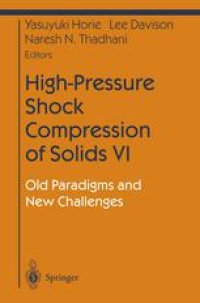
Ebook: High-Pressure Shock Compression of Solids VI: Old Paradigms and New Challenges
- Tags: Solid State Physics, Spectroscopy and Microscopy, Condensed Matter Physics, Characterization and Evaluation of Materials, Continuum Mechanics and Mechanics of Materials
- Series: Shock Wave and High Pressure Phenomena
- Year: 2003
- Publisher: Springer-Verlag New York
- Edition: 1
- Language: English
- pdf
Both experimental and theoretical investigations make it clear that mesoscale materials, that is, materials at scales intermediate between atomic and bulk matter, do not always behave in ways predicted by conventional theories of shock compression. At these scales, shock waves interact with local material properties and microstructure to produce a hierarchy of dissipative structures such as inelastic deformation fields, randomly distributed lattice defects, and residual stresses. A macroscopically steady planar shock wave is neither plane nor steady at the mesoscale.
The chapters in this book examine the assumptions underlying our understanding of shock phenomena and present new measurements, calculations, and theories that challenge these assumptions. They address such questions as:
- What are the experimental data on mesoscale effects of shocks, and what are the implications?
- Can one formulate new mesoscale theories of shock dynamics?
- How would new mesoscale theories affect our understanding of shock-induced phase transitions or fracture?
- What new computational models will be needed for investigating mesoscale shocks?
Content:
Front Matter....Pages i-xiv
Traditional Analysis of Nonlinear Wave Propagation in Solids....Pages 1-55
Paradigms and Challenges in Shock Wave Research....Pages 57-119
The Universal Role of Turbulence in the Propagation of Strong Shocks and Detonation Waves....Pages 121-148
What is a Shock Wave? —The View from the Atomic Scale....Pages 149-168
Meso-Macro Energy Exchange in Shock Deformed and Fractured Solids....Pages 169-213
The Shock Wave as a Nonequilibrium Transport Process....Pages 215-254
Non-Equilibrium Evolution of Collective Microdamage and Its Coupling with Mesoscopic Heterogeneities and Stress Fluctuations....Pages 255-278
Responses of Condensed Matter to Impact....Pages 279-296
The Discontinuous Shock—Fact or Fancy?....Pages 297-321
What Is a Shock Wave to an Explosive Molecule?....Pages 323-340
Back Matter....Pages 341-351
Content:
Front Matter....Pages i-xiv
Traditional Analysis of Nonlinear Wave Propagation in Solids....Pages 1-55
Paradigms and Challenges in Shock Wave Research....Pages 57-119
The Universal Role of Turbulence in the Propagation of Strong Shocks and Detonation Waves....Pages 121-148
What is a Shock Wave? —The View from the Atomic Scale....Pages 149-168
Meso-Macro Energy Exchange in Shock Deformed and Fractured Solids....Pages 169-213
The Shock Wave as a Nonequilibrium Transport Process....Pages 215-254
Non-Equilibrium Evolution of Collective Microdamage and Its Coupling with Mesoscopic Heterogeneities and Stress Fluctuations....Pages 255-278
Responses of Condensed Matter to Impact....Pages 279-296
The Discontinuous Shock—Fact or Fancy?....Pages 297-321
What Is a Shock Wave to an Explosive Molecule?....Pages 323-340
Back Matter....Pages 341-351
....